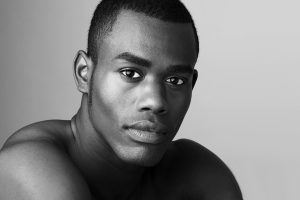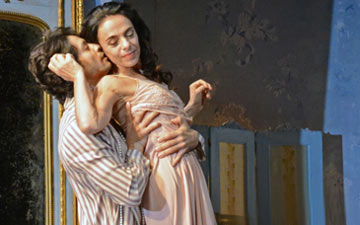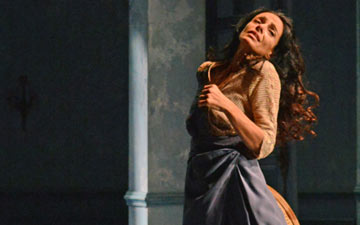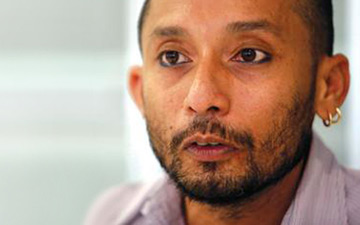
© Martha Clarke, courtesy the Royal Opera House.
Feature: Chéri feature + Herman Cornejo interview – NY, Dec 2013
Review: Martha Clarke’s Chéri in Washington – Oct 2014
London Performances of Chéri
Royal Opera House, Linbury Studio Theatre
29 Sept – 4 Oct 2015
Full Details
Martha Clarke talks to Jann Parry about Chéri – at the ROH Linbury Studio Theatre, 29 Sept – 4 Oct 2015
Alessandra Ferri had changed her mind about retiring from ballet when she took on Martha Clarke’s project, Chéri (at the Linbury Studio 29 September to 3 October). The two had hoped to work together for years, but their schedules were never right. Then in 2012, when Clarke was longing to turn Colette’s 1920s novellas about a young man in love with an older woman into a dance-theatre piece, they met up again in New York. Ferri, who had stopped dancing in 2007, was Director of Programming for the Spoleto Festival, and her marriage of 15 years had come to an end.

© 2013 Joan Marcus. (Click image for larger version)
‘Alessandra was ready to give herself to the role of Léa, now that she is in her fifties’, says Clarke. ‘When I saw Herman Cornejo dancing with American Ballet Theatre, I knew he’d be right as Chéri – but he’d never partnered Alessandra while she was with ABT. We did a workshop to see whether my idea might gel, and the chemistry was instantly electric. All I had to do was get a theatre involved.’ She laughs: as a freelance, she has to find funding for uncommissioned projects.
The enterprising Signature Theatre in New York (on W42nd Street) invited her to be its writer-in-residence for five years, so Chéri was created there and given its premiere in December 2012 before going on a world tour. It has been enthusiastically received, with reviewers marvelling at Ferri’s passionate, unstinting performance and Cornejo’s willingness to forgo his virtuosity in favour of sympathetic acting.

© Joan Marcus. (Click image for larger version)
‘They’ve danced together a lot since the premiere, in other pieces as well as Chéri , so they are experienced as partners’, says Clarke admiringly. ‘They are both extraordinary performers. They contributed a lot to the making of Chéri because I’m not really a ballet choreographer – I care less about steps than what is emotionally truthful.’ She acknowledges that she’s indebted to Antony Tudor’s work, having studied ballet under him when she was a young student at the Julliard School of music, dance and drama. ‘I guess I’m a little crab apple from Tudor’s apple tree because what I care about most is good story-telling and emotional clarity’.
After Julliard, Clarke joined Pilobolus, the shape-making physical-theatre group, as a founder member in 1971. She moved on in 1978 to become a director of theatre, music-theatre and opera, as well as making her own creations. Probably her best-known work, The Garden of Earthly Delights, based on the Hieronymus Bosch painting, was performed by Rambert Dance Company in the 1990s. She has worked in Britain with the National Theatre, Glyndebourne Opera and English National Opera. ‘I have great curiosity’, she says. ‘I love doing research and collaborating with new people, though I have a small circle of people I particularly like to work with – designers, actors, dancers who’ve come from Twyla Tharp or Bill T. Jones and then go off elsewhere.’
For Chéri, she collaborated with a designer new to her, David Zinn, ‘who is now hot’, she says proudly, and a lighting designer, Christopher Akerlind, with whom she’s worked for 13 years. Renowned pianist Sarah Rothenberg assembled the score, which she plays onstage, from piano music by composers contemporary with Colette – Debussy, Ravel, Poulenc and Mompou.
When I ask whether the pianist is a character in the drama, Clarke replies ‘No – though Sarah is a character. The dancers respond to her like a good jazz trio, playing off each other. They know when to be still, when to let go.’ An actress takes the role of Chéri’s acerbic mother, her spoken interventions providing information that dance alone could not: how the liaison between her callow son and mature Léa started, how time passed and the First World War changed everything, what happened next. The original American actress, Amy Irving, has been replaced in London by British actress Francesca Annis, with whom Clarke has been rehearsing before the London premiere. ‘The chemistry will be different, which I enjoy, and so will the dancers.’

© Joan Marcus. (Click image for larger version)
I ask her opinion of the potential dilemma for a choreographer working with an older dancer, as Wayne McGregor did with Ferri in Woolf Works, where she represented Virginia Woolf and her fictional character, Mrs Dalloway. Should the choreographer stay true to the character’s age, revealing a limited mobility compared with that of younger performers, or make the most of what the performer can still do as a supple dancer? How is the audience supposed to know that the character is ageing if she is flung about acrobatically?
Ferri is remarkable at 52 for returning to dance much as she did as a youngster, her limbs as mobile as ever. (She is due to reprise the role of Juliet with ABT in June next year, nine years after retiring from the company.) Clarke says that as Léa, the dancer is expressing what the character feels inside, not her age. She is desperately in love, so she goes physically as well as emotionally to extremes. In Colette’s second novella, La Fin de Chéri (The End of Chéri), Léa is plump, no longer the beauty she was, so Chéri rejects her: Ferri is harshly lit, deliberately exposing her lean, angular physique. Her anguish at losing Léa’s young lover is Ferri’s own interpretation of the role, a combination of Colette’s vision and her own experience as a woman and a dramatic ballerina.

© Joan Marcus. (Click image for larger version)
“What I’m aiming for is that crossover, that interval between physicality and pure theatre’, Clarke explains. ‘Because Alessandra understands who Léa is, she lives her on stage. And Herman reacts to her in a different way from Colette’s Cheri because he’s a muscular, virile dancer, not a spoilt boy. They can dance the sexual rapture between them as well as the disillusion.’
Clarke, in her 70s, has several projects under way. There is to be a revival in February 2016 of Angel Reapers, described as ‘a wildly theatrical collage of modern dance, music, Shaker songs and movements’, celebrating godly love and the urgings of the flesh. She is developing a new work about St Francis of Assissi, for which she hopes to cast a British actor – and, of course, animals. Clarke has often worked with animals, including an elephant, a horse and a bulldog, who stole a show in the role of Queen Victoria.

© Joan Marcus. (Click image for larger version)
She lives in Connecticut, surrounded by animals, domestic and wild, in a house originally owned by Arshile Gorky, the Armenian-born Abstract Expressionist painter. Although she has a flat in Manhattan for work purposes, she much prefers the countryside. She won’t be staying long in London once Chéri is in performance at the Linbury because ‘I have a new rescue dog to get back to – he’s a beautiful mover.’

















Seeing, Ferri and Cornejo dance together for the first time at the Signature Theater was one of thse rare truly exiting evenings. They have been two of my all time favorites but I never thought I would ever see them together. Thank you Marth Clarke.